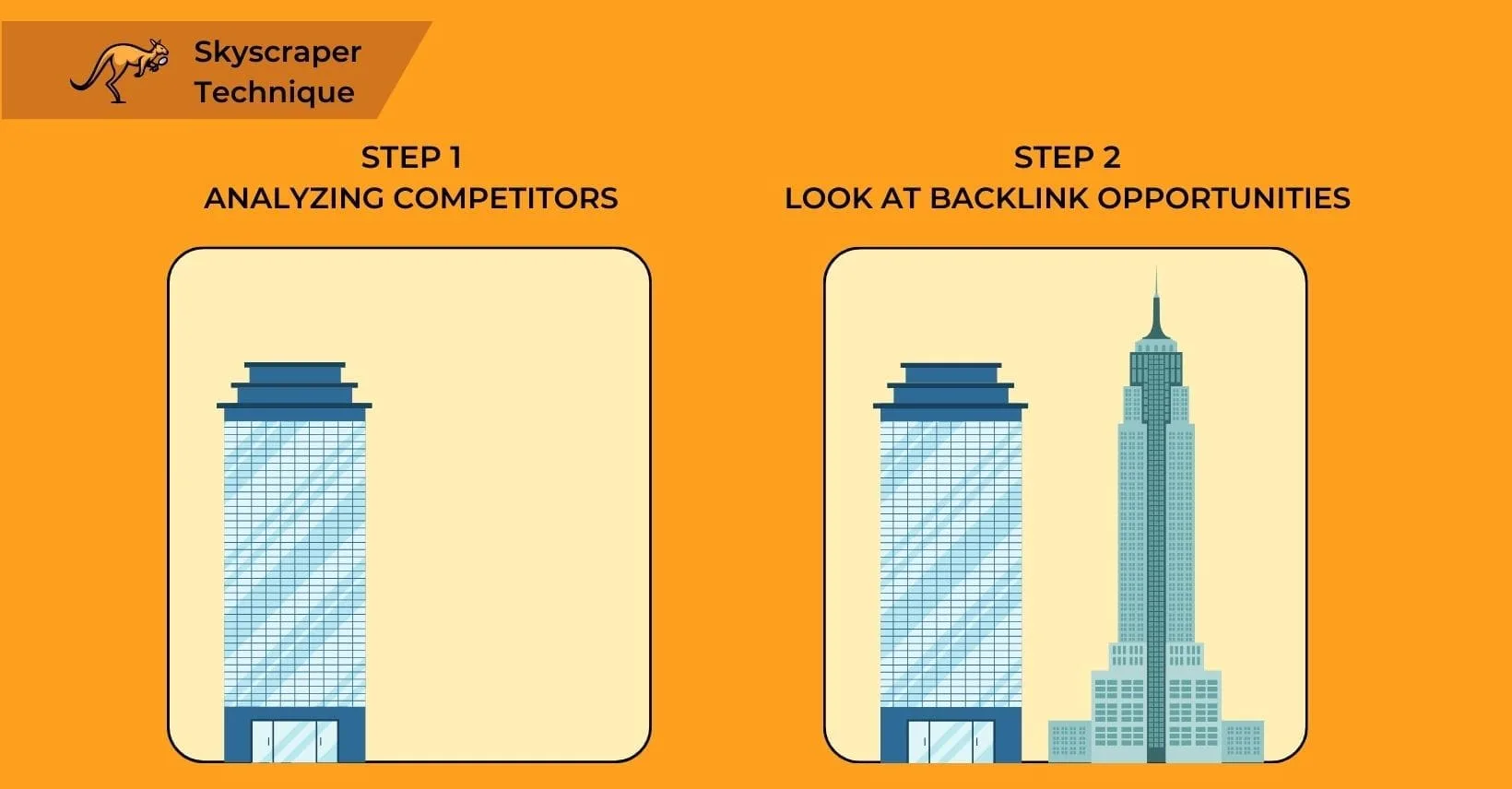Investing in referring domains through the Skyscraper Technique aims for optimal SEO results with minimal effort, fostering rapid growth.
While frequently discussed among SEO enthusiasts, the depth of its potential benefits often remains unexplored.
This strategy, contingent on market dynamics and user execution, can elevate content to achieve superior growth when applied correctly.
But the underlying mechanisms and effectiveness of the Skyscraper Technique compared to other link-building strategies prompt a closer look.
What exactly encompasses this technique, and how does it stand out in the competitive field of link building?
What is the Skyscraper Technique in SEO?

The Skyscraper Technique is an SEO strategy that aims to surpass the top-performing content within a specific niche by creating superior material that becomes the new benchmark for quality and relevance in search results.
The Skyscraper Technique works by identifying highly successful content with existing backlinks and crafting an improved version that compels websites to redirect their links to your updated content, which effectively renders the original obsolete and transfers authority to your site.
With enhancements in accuracy, depth, and relevance tailored to specific audiences, this method positions your content as a new focal resource and redirects traffic and backlinks to your site. This innovative approach to content improvement naturally raises the question of who originally developed such a strategic method.
Who Created the Skyscraper Technique?
Brian Dean of Backlinko created the Skyscraper Technique, which revolutionized link building by emphasizing superior content creation that secures higher Google rankings through quality backlinks.
This method initially relied heavily on Brian Dean’s experiments and insights, highlighting the importance of quality over quantity. Over time, as more SEO professionals adopted and adapted the method, it evolved into a refined strategy that now serves as a cornerstone in modern link building practices. The effectiveness of producing high-quality content that outshines competitors has made many wonder about the broader implications of this technique on their SEO efforts.
Why Use the Skyscraper Technique?
The Skyscraper Technique hinges on identifying high-ranking content within your niche to serve as a benchmark. Even if this content already attracts significant backlinks from major websites, there’s an opportunity to divert some of these links by creating superior content. Key to this strategy is pinpointing content that not only ranks well but also captivates and converts. High-value content types, such as how-to guides, comparative analyses, listicles, detailed product reviews, and visual aids like infographics and cheat sheets, are particularly effective. These resources naturally draw more attention and backlinks than standard opinion articles or casual posts because they provide tangible value to their audience. Given the pivotal role of existing backlinks in this strategy, it’s more beneficial to focus on enhancing content that has already proven its link-worthiness rather than content still striving to gain traction. As we delve deeper into refining this method, our next step involves thoroughly examining these top-performing competitors.
Implementing the Skyscraper Technique follows four essential steps: finding link-worthy content with existing backlinks, analyzing competitors’ backlink profiles, creating significantly improved content that surpasses the original, and conducting targeted outreach to sites linking to the original content.
Analyzing Competitors
Using backlink analysis tools to examine your competitors’ content uncovers high-quality links pointing to their sites. You gain insights into what appeals to your shared industry or audience by identifying the most linked content. Various backlink report tools can detail a page’s backlink profile, providing immediate access to a list of linking sites and evaluating their value. This analysis sets the stage to investigate potential link-building avenues further
Look at Backlink Opportunities
Once you have gathered the data, you must sift through and identify which sites offer valuable links. Not all sites will be relevant or beneficial. Examine both the sites that link and the content they feature. If the top content on a site is unrelated to your industry, avoid mimicking it to maintain relevance. Prioritize obtaining a link from a diverse array of domains rather than multiple links from a single domain, as this approach amplifies your SEO impact. Focus on sites that align with your industry and could significantly enhance your SEO if they link to your content. With your targets identified and relevant content at hand, you’re well-prepared to take the next step: creating content that others will want to link to.
Creating Link-Worthy Content
The essence of the Skyscraper Technique involves crafting content that matches and exceeds that of your competitors. To achieve this, your content must attract high-quality backlinks and outperform the current top contenders in your niche. This approach positions your content as the superior alternative, setting a new benchmark for excellence in your field. While the prospect of surpassing well-established content might seem daunting, much of the groundwork lies in leveraging existing frameworks and subtly enhancing them, which paves the way for further refinements.
Improving Your Content Past Competitors
Creating link-worthy skyscraper content requires leveraging competitor content as a benchmark and then enhancing existing information by adding original research, expert insights, visual elements, and comprehensive data that surpasses the original in quality, depth, and user experience. This strategy may involve incorporating additional details, integrating expert opinions, improving the user experience, and including rich media such as videos and images. For instance, when enhancing an article about selecting the best web browser, you could expand on the unique features of each browser to provide a more detailed comparison. Enriching your content with more comprehensive data and insights naturally becomes more extensive and informative. However, maintaining relevance is crucial. It’s important to adhere closely to the intended keywords and target audience to avoid negative impacts on SEO due to off-topic content.
An essential step in your content strategy will involve optimizing this enriched content to ensure it not only meets but exceeds user expectations and search engine criteria
Optimizing Content

Optimizing your content for search engines remains a prudent strategy. Effective on-page SEO enhances your content’s visibility and increases search engine traffic. Employing keywords similar to those used by your competitors can streamline the process, improving your content’s ranking and easing future marketing efforts. Choosing the right keywords is crucial and should involve tools that help assess keyword difficulty and search volume.
The skyscraper technique elevates your content’s position and is a robust link-building strategy. This approach requires a sharp focus on both keywords and link quality. The foundational steps include relying on solid data for keyword choices and identifying achievable link targets.
That said, the natural progression leads us to continuously explore and adapt, ensuring that each step we take builds upon the last and opens new avenues for growth and effectiveness. This ongoing evolution encourages us to think about further enhancing our practices and outcomes.
Be Transformative and Be Better
A common misuse of the skyscraper technique involves merely replicating content from other websites, which can lead to suboptimal search engine rankings and does not leverage the method’s potential to elevate the quality of internet content. The skyscraper technique aims to enhance the value of existing information, transforming it into superior content by integrating and expanding upon the insights gleaned from various sources, such as combining features from several how-to guides into a comprehensive new one. True effectiveness of this strategy requires innovating beyond the original by adding new dimensions to the content created. With these strategies in mind, a well-planned approach can effectively extend the reach of this enhanced content, paving the way for engaging broader audiences through strategic communications.
Conducting an Outreach Campaign
The outreach process for the Skyscraper Technique begins once your superior content is published, when you systematically contact websites currently linking to competitor content, explaining why your resource provides more value to their audience and requesting they consider linking to your improved version instead. You should communicate the advantages of your content, such as being a more comprehensive or less biased resource compared to original references. Achieving this means high-quality websites will link to your content, enhancing your visibility and credibility, even if they continue linking to the sources. As these quality connections are established, consider the next steps in expanding your outreach: identifying your best prospects, locating their contact information, and crafting effective pitches to further your content’s reach.
Identify Your Best Prospects
The skyscraper technique can be approached in a range of ways, but you always want to target likely prospects for link building.
A backlink analysis is the best way to get a full look at your link building opportunities, especially because it can show you how effective the link would actually be.
Using keyword research tools can also help you find the best keywords for maximum organic search traffic.
Together, this information makes it easier to create link-worthy content that has a chance of being noticed rather than content marketing to an audience or niche that does not really exist.
Tools like Site Explorer make it easy to narrow down your options since Site Explorer can quickly show you the backlink profile of your target site without more than a small delay.
Of course, gathering data through tools like Site Explorer is only part of the process. You can also sometimes find obvious signs of potential.
For example, broken links (links that no longer lead to a valid page) are an invaluable asset because they highlight a link that needs to be replaced. If no other content is available, the site owner is basically forced to either link to you or delete the link entirely.
Find Contacts
While you could wait until sites naturally want to link to your blog post or article, this can take a long time and does not have any guarantee of success. Approaching sites directly is a much more effective option.
Finding backlink prospects involves using tools like Site Explorer to identify websites linking to competitor content, after which you locate their contact information through author pages, about sections, or dedicated contact pages before sending personalized outreach emails that highlight the specific improvements in your content.
Looking at articles might provide you with writer emails or other contact options.
If you are trying to do this in bulk, then a proper email outreach tool can really help with contacting a range of writers across multiple sites all at once.
Send Pitches
Identifying target sites for your outreach efforts is the first step. Next, you must compose pitches, ideally in personalized emails. These pitches should clearly articulate the advantages of linking to your content over others, emphasizing updates and enhancements that you offer. Strive for a friendly and cooperative tone, presenting yourself as someone eager to enhance the existing content they link to. Highlight aspects such as the comprehensiveness and freshness of your article, which could benefit their audience. When dealing with long-form content, pinpoint specific, updated information that aligns closely with the core topics of the recipient’s content. If your article addresses and corrects critical errors in their current references, draw attention to these corrections. Selecting an approach to pitch creation is flexible; adapt your strategy to suit the context of each target site best.
Having mastered the art of pitch crafting, you are well-prepared to elevate your outreach with the Skyscraper Technique, a strategy designed to enhance the efficacy and reach of your content further.
How to Perform the Skyscraper Technique Successfully
Brian Dean’s Skyscraper Technique improves SEO performance by systematically building high-quality backlinks from authoritative domains that recognize your superior content, which increases domain authority, improves search rankings, and drives targeted organic traffic to your website. Each step of the process must be executed meticulously to gain a competitive edge in tough markets. The Skyscraper Technique differs from other SEO strategies by focusing on content quality improvement rather than quantity of outreach, which requires identifying superior content opportunities based on existing backlink profiles and leveraging genuine value propositions that appeal to both site owners and their audiences. As we go further into creating unparalleled content, understanding how to discern and capitalize on these opportunities will be key to mastering the art of content enhancement.
Build The Best Content Possible
Identifying content for the Skyscraper Technique requires finding popular pages with numerous backlinks that contain outdated information, insufficient depth, or poor presentation, which creates opportunities for producing substantially improved versions that attract links. When aiming to supersede a longstanding article, simply aggregating copied information into a disjointed article falls short; instead, the goal is to provide distinct, valuable content. This approach involves enhancing the content’s readability, clarity, and overall value, moving beyond merely satisfying search engine algorithms. For example, a well-structured guide or tutorial is more effective than a blog post overloaded with keywords but lacking substance. As you refine your content to meet these standards, consider also the balance between being proactive in your strategies and the risk of crossing into aggressiveness, which we will subtly touch on next.
Be Proactive, But Not Aggressive
The skyscraper technique capitalizes on proactivity, engaging other websites to foster link creation rather than passively waiting for them. This method demands continuous effort—constantly sending pitches and refining content to maintain engagement and momentum. When one content piece is finalized, it’s strategic to commence work on another, utilizing any response delays to identify new skyscraper targets and sustain the cycle. This proactive cycle optimizes your backlink profile and sets the stage for enhancing organic traffic.
Don’t Forget Organic Traffic
The skyscraper technique, while powerful, should not overshadow other valuable strategies. It’s important to remember that organic search traffic holds considerable value and that links from various domains, even those that do not rank at the top, can be beneficial. Employing your skyscraper article as a multi-use tool for link building can increase decent quality referring domains. This technique also integrates well with other methods, such as utilizing backlinks reports to identify and target less prominent domains that are still worthwhile for consistent link-building efforts. Applying practical judgment will be essential as you continue to build your strategies.
Use Common Sense
When applied to link building, the skyscraper technique requires precision to avoid common pitfalls such as misaligned content that doesn’t contribute effectively to ranking goals.
As with other link-building methods, adherence to established guidelines remains crucial; neglecting this can jeopardize your links and organic traffic.
For example, if you want to rank higher on Google search results for specific terms, make sure that you use referring domains with some relevance to those keywords.
While viewing the skyscraper technique as a standalone strategy is tempting, it should integrate seamlessly into your broader link-building efforts. This systematic approach ensures content relevance and optimizes ranking potential.
Moving forward, adopting a mindset where each piece of content is treated as uniquely crafted will further enhance your strategy’s effectiveness, paving the way for more tailored and impactful engagement.
Treat Each Piece of Content as Bespoke
It is important to try and put as much effort as possible into your content when you use the skyscraper technique.
As mentioned before, both site owners and search engines want quality content, so having better content overall will lead to greater results.
However, you also want to slow down and take the entire project one step at a time, especially if you are trying to steal a particularly valuable link.
Try to avoid relying too much on a specific formula or re-using the formatting of one article for another. This might be easier, but it also makes you complacent.
A large part of the skyscraper technique is about pushing forward and filling niches in ways that other sites are not. To do this, you need to actually pay attention to what your content is and what makes it more valuable than the content you want to replace.
A large part of what pushed Brian Dean to his original level of success was using well-made content and carefully planned pitches, using templates but hiding the fact that they were not entirely unique.
Even if you are taking shortcuts like this, you want to disguise it as much as possible. The skyscraper technique relies on providing value and making the target site want to use your content
Beyond the Basics: Advancing Your SEO
The skyscraper technique is a versatile strategy that can provide a lot of solid benefits and does not necessarily take much time to understand once you know what the goals are meant to be.
However, unlike many SEO or link building strategies that use generalized techniques, the skyscraper technique is more focused on individual pieces of content.
This makes it more specialized and bespoke but also more powerful, especially if you can land a link replacement from a major website that begins to treat you like a major resource or point of reference.
Just remember that there is no perfect way to approach the skyscraper technique and no guaranteed sub-strategies that will work in any industry.
Slow down, explore your options, and remember that the skyscraper technique is meant to be only part of a greater SEO whole.





